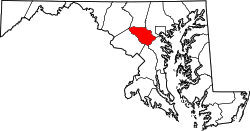References
- ↑ "TO PROTECT WORKMEN: Death Said to Have Been Caused by Flint Dust GOV. BROWN MAKES INVESTIGATIONS The Attention of the Legislature to Be Called to the Process Used by the Patapsco Flint Mill Company at Hood's Mill, Carroll County". The Baltimore Sun. February 27, 1894.
- ↑ "THROWN INTO A MILL RACE". The Baltimore Sun. May 11, 1893.
- ↑ Barbara Feaga. Howard's Roads to the Past. p. 57.
